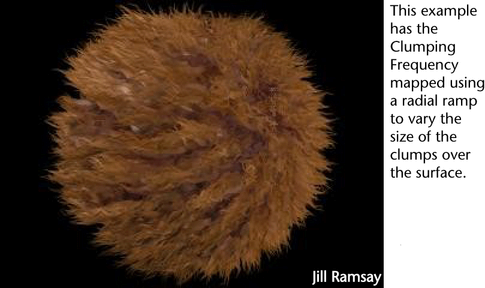You can create clumps of fur, such as wet or matted fur, for a whole range of fur looks.

In the Fur Description Attribute Editor there are three attributes to create and control clumping: Clumping, Clumping Shape, and Clumping Frequency. As with all Fur attributes, painting and mapping are supported.
In order to preview clumping accurately, the Fur Accuracy attribute must be set to 1 (default), which is in the shape node of the Fur Feedback Attribute Editor.
Clumping respects other attributes, including Inclination, Roll, and Polar. For example, if Inclination is set to 1 so the fur is lying flat, then the clumps lie flat too.
With clumping there may be the appearance of gaps between the clumps on the surface of the object. To correct this use one or more of the following solutions:
To create clumps of fur on part of an object, for example, on the chest fur of a cat
To map or paint ranges that are greater than 0 to 1, such as Clumping Frequency
Now you can paint or map the attribute as usual. White will represent the Multiplier value (100), black will represent 0, and grayscale values will be distributed evenly between.
To map or paint ranges that can be negative, such as Clump Shape